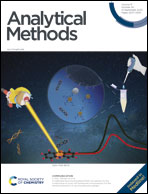A methylene blue-functionalized DNA concatemer for the construction of a turn-off fluorescent immunosensor for the sensitive detection of carcinoembryonic antigen†
Abstract
This study showed a method of synthetization of a methylene blue-functionalized DNA concatemer via hybridization chain reaction (HCR) used for turn-off fluorescence detection of carcinoembryonic antigen (CEA). During the experiments, CEA aptamers and the methylene blue-functionalized DNA concatemer were modified onto the surface of Au nanoparticles (AuNPs). By detecting the signal of remaining methylene blue in the solution that has not been embedded in the DNA concatemer, we obtained an amplified decrease of the fluorescence signal at 695 nm for CEA. The linear range was from 0.1 to 80 ng mL−1 with a limit of detection at 75 pg mL−1 for CEA determination. Our results showed that the proposed method had good selectivity and could generate satisfactory results for clinical serum sample determination. Based on the positive outcomes obtained, we determined that the method provided a sensitive and accurate way for early clinical diagnosis of cancer disease.



 Please wait while we load your content...
Please wait while we load your content...